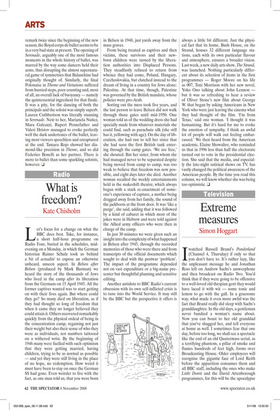Taste for the unusual
Giannandrea Poesio
Overture 2012: Power and Passion Royal Albert Hall Julie Gilbert/Jean-Baptiste André The Place Triple Bill Royal Opera House
Ihave to confess that the idea of 120 children and teenagers dancing to Shostakovich’s 10th Symphony did not sound particularly appealing. I have nothing against children, but their performances bore me to death. The problem is also that when it comes to children one can never say what he/she really thinks; last time I did so, I had to hide from irate parents and relatives calling me an ogre and wanting me burnt at the stake. Still, the fact that Royston Maldoom’s Overture 2012: Power and Passion had been included in this year’s Dance Umbrella stimulated my curiosity. After all, the presentation of unusual performances has been one of the most distinctive and successful traits of the 2008 Umbrella programme. Maldoom is a true master in making masses of non-dance professionals move to ‘important’ music played by ‘important’ orchestras, as those who were lucky enough to attend his Rite of Spring with Simon Rattle and the Berliner might vividly recall. This time, too, he has scored a success, involving youngsters between six and 17 in a choreographic discovery of Shostakovich’s musical genius, perfectly highlighted by an intoxicating performance by the London Symphony Orchestra under the baton of FrançoisXavier Roth. A discovery indeed, is what Overture 2012 is for its own performers, as they engage with the biographical and artistic struggles suffered by the composer under Stalin’s regime, narrated so vividly by his own notes. As someone who manages to remain cold-heartedly unaffected by the presence of little darlings on stage, I managed to focus on the visually impressive sequence of choreographic ideas and appreciate in full how the performers responded to the music. Personally, I would have done without some of the more descriptive ideas — even though the joy expressed by the little fellow who climbs on to Stalin and realises the tyrant is dead is a liberating coup de théâtre.
‘Unusual’ is also the adjective one could use in relation to Julie Guilbert’s and JeanBaptiste André’s performance at The Place, earlier in the week. Their two solos, devant l’arrière pays and comme crane, comme culte, choreographed respectively by Stijn Celis and Christian Rizzo, were essays in the art of pure movement. The former, clearly informed by Butoh Expressionism, relied on a number of provocative ideas, in which the performer’s body and face twisted and moved to the extreme of physical tension, causing both amusement and uneasiness among the viewers. The latter showed the extent of André’s ability as both acrobat and dancer, using exasperating repetitions to provoke and test the audience in pure postmodern terms. Much as the two performers were to be admired for their own skills, the two pieces came across as slightly déjà vu and dated, given that both Butoh and acrobaticised pedestrianisms are ‘so yesteryear’, as a garishly dressed cultural fop remarked on the way out.
On the ballet front, the week kicked off with a newly assembled Royal Ballet Triple Bill, in which Michael Corder’s L’Invitation au voyage was sandwiched between two Balanchine blockbusters, Serenade and Theme and Variations. Interesting as it may sound on paper, the compound programme does not work on stage. Corder’s ballet, a delicate reverie inbetween Romanticism and Impressionism, is anything but an ideal match for the two Balanchine pieces. Its delicate palpitations have nothing in common with the powerful lyricism of Serenade and are certainly no match for the Imperial Ballet’s grandeur of Theme and Variations. In my view, though, the ill-assembled programme was not the main problem of the evening. As I have already had reason to remark twice since the beginning of the new season, the Royal corps de ballet seems to be in a very bad state at present. The opening of Serenade, arguably one of the most famous moments in the whole history of ballet, was marred by the way some dancers held their arms, thus disrupting the almost supernatural game of symmetries that Balanchine had originally thought of. Similarly, the final Polonaise in Theme and Variations suffered from hurried steps, poor counting and, most of all, an overall lack of buoyancy — namely the quintessential ingredient for that finale. It was a pity, for the dancing of both the principals and the soloist was simply superb. Lauren Cuthbertson was literally stunning in Serenade. Next to her, Marianela Nuñez, Mara Galeazzi, Rupert Pennefather and Valeri Hristov managed to evoke perfectly well the dark undertones of the ballet, leaving most viewers speechless and enraptured at the end. Tamara Rojo showed her diamond-like precision in Theme, and so did Federico Bonelli as her partner. There is more to ballet than some sparkling soloists, however. ❑



















































































 Previous page
Previous page